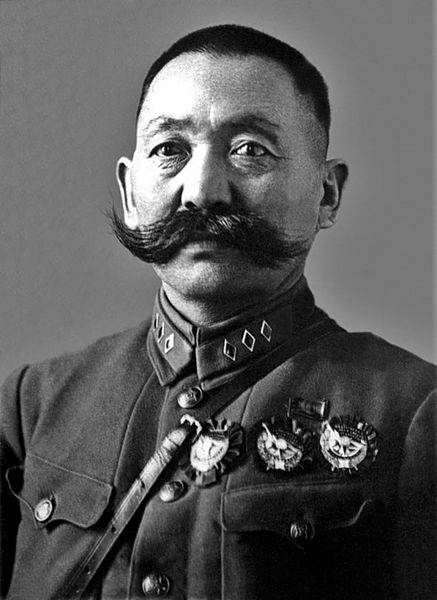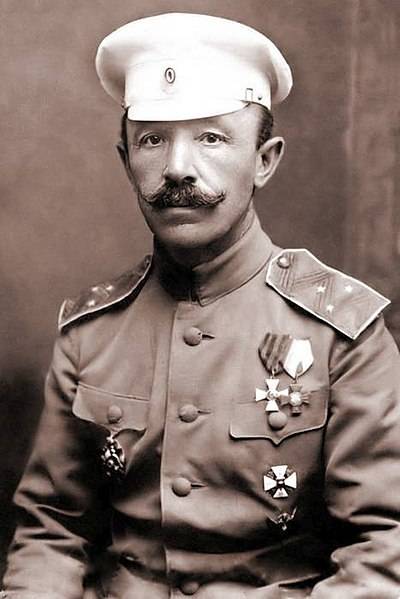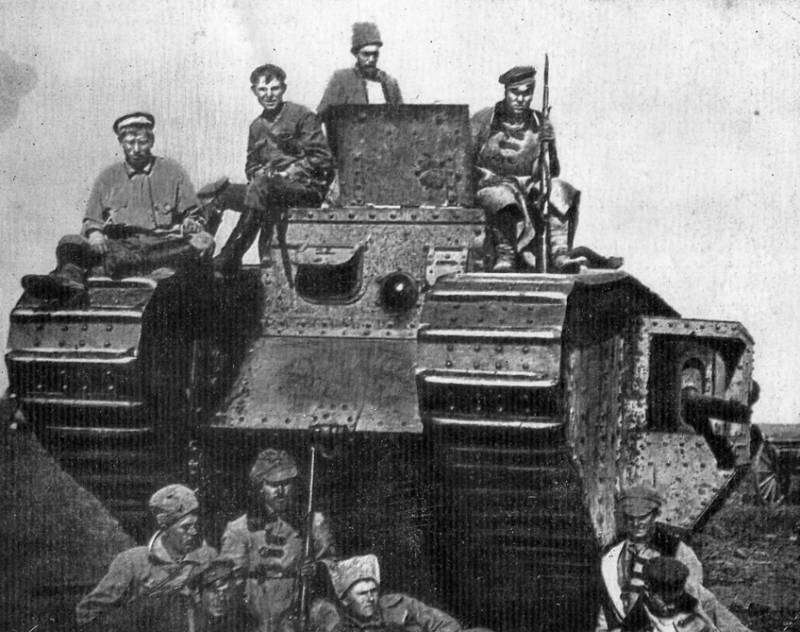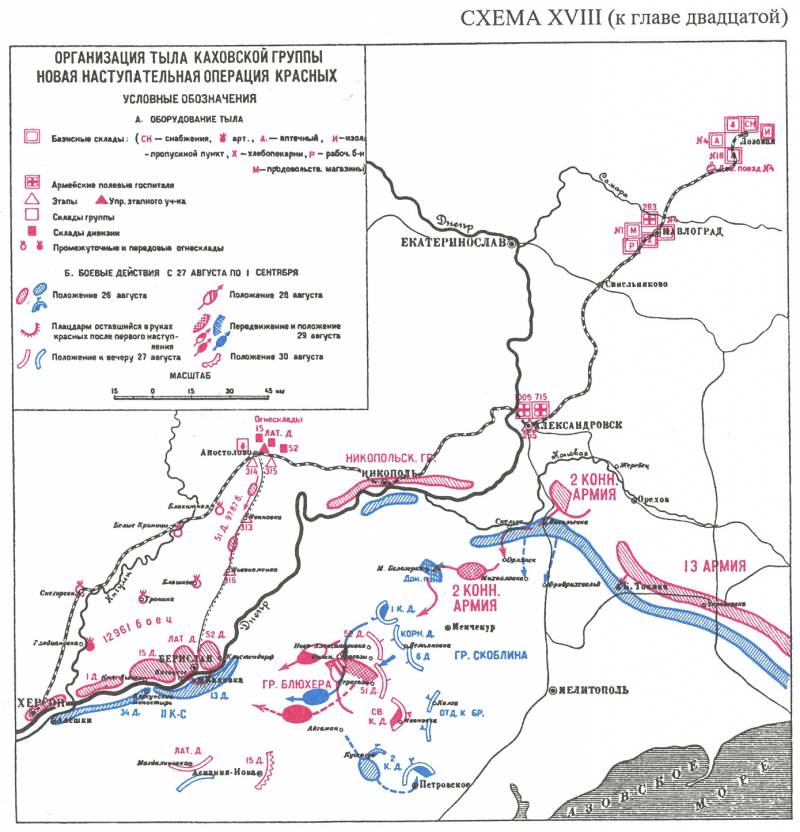The fierce battle for the Kakhovsky bridgehead
Slashchev and Barbovich stopped the enemy and threw them back to the Dnieper. However, here the whites ran into the powerful Kakhovsky fortified area, occupied by fresh units of the Blucher division. Barbed wire and dense and well-organized artillery fire stopped Barbovich's cavalry. As a result, all the attacks of the White Guards on Kakhovka on August 13-15 crashed against the powerful defense of the Reds.
Preparing for a new battle
In mid-July 1920, there was a relative calm on the Crimean front. Both sides were actively preparing for new battles. The command of the white Russian army was preparing for a new offensive with the aim of expanding its territory, seizing vital resources, including human resources. The Red Army was preparing for a new attempt to destroy the White Guards.
By August 1920, Wrangel's army had grown considerably stronger. The seizure of Northern Tavria and the defeat of the Redneck Cavalry Group made it possible to transplant several thousand Cossacks onto requisitioned and captured horses. Due to the mobilization in Tavria, rear units and garrisons, due to the captured Red Army soldiers (both sides during the war actively included ordinary prisoners in their ranks), the thinned parts were replenished. Several Makhnovist and Petliura chieftains went over to Wrangel's side. The Russian army on the front line had 35 thousand bayonets and sabers (more than 55 thousand people in total), 178 guns, 38 aircraft. After the victory over the 13th Soviet army (groups of Rednecks and Fedko), the White Guards regrouped: the Don and Consolidated corps were united; Slashchev's 2nd Army Corps was transferred from the northern sector of the front to the western one and took up defensive positions along the Dnieper; The 1st Army Corps of Kutepov was sent to the northern sector of the front.
By the beginning of August 1920, the Red Army was also significantly strengthened. The strength of the 13th Soviet Army has been increased to 58 thousand soldiers, about 250 guns and 45 aircraft. It was headed by a new commander - Uborevich. At the same time, new units and reinforcements were constantly transferred to the Crimean direction. So, against the Wrangelites, the 51st Infantry Division of Blucher was transferred from Siberia. It was one of the most powerful divisions of the Red Army: 16 regiments, its own artillery and cavalry (a whole corps). Given the shortcomings of previous battles, the Soviet aviation was united under a single command of I. Pavlov.
Also, the Soviet command realized the need to strengthen mobile formations on the Crimean front. On July 2, the 16nd Cavalry Army under the command of O. Gorodovikov was formed from the remnants of the Zhloba's cavalry corps, the 2nd Cavalry Division and other units on the Crimean direction. He was an experienced commander, a Cossack-Kalmyk by birth, fought in the tsarist army, after October he went over to the side of the Bolsheviks. Gorodovikov fought under the command of the famous generals Dumenko and Budyonny, commanded a partisan detachment, a platoon, a squadron, a cavalry regiment, a brigade and the 4th cavalry division. He fought successfully with the troops of Krasnov and Denikin, with the Poles. The 2nd Cavalry Army included the 2nd Cavalry Division. Blinov, 16th, 20th and 21st cavalry divisions. Initially due to lack of personnel, horses, weapons and equipment, the army was small - about 5,5 thousand soldiers (according to other sources, about 9 thousand people), 25 guns and 16 armored vehicles.

To Aleksandrovsk and Yekaterinoslav
The Soviet command was planning an offensive at the beginning of August 1920, but the White Guards were ahead of the enemy. After the defeat of the group of Goons, the White Guards regrouped and almost immediately launched an offensive, preventing the 13th Soviet Army from recovering. White threw back the enemy troops, who were still trying to attack in the direction of Mikhailovka and Bol. Tokmak. On July 25, 1920, Kutepov's corps, which replaced parts of Slashchev in the northern section, dealt a powerful blow to Aleksandrovsk and Yekaterinoslav. Markov and Drozdovskaya divisions defeated the 3rd and 46th rifle divisions of the 13th army. One of the red brigades was surrounded and suffered heavy casualties. The Wrangelites captured the town of Orekhov.
The white command introduced the Kuban Cossack division of General Babiev into the gap. To build on his success, Wrangel transferred Barbovich's Horse Corps to this area. However, the Reds quickly came to their senses and began to violently counterattack with the forces of the 2nd Cavalry Army (16th and 20th Cavalry Divisions) and units of the 40th Infantry Division. White continued to attack, but at the cost of great efforts and losses. Soon the White Guards managed to take the important railway junction Pologa and on August 2 Aleksandrovsk, which was bypassed by the White cavalry. On the southern flank, the Don Corps defeated the 40th Infantry Division.
The successes ended there. The white parts fizzled out, lost their striking power. The resistance of the Red Army increased markedly. The Reds quickly pulled up reinforcements and closed the breaches, then counterattacked. The white army began to withdraw to its former positions. On August 4, the Wrangelites left Aleksandrovsk, two days later - Orekhov and Pologi, on August 8, White Berdyansk fell. Thus, the white command was unable to achieve decisive success in the northeastern sector of the front.

Kakhovka
After repelling the enemy blow, the Red Army launched an offensive. Its plan as a whole repeated the tasks of the previous operation: the main strikes from the west of Kakhovka to Perekop and from the northeast to Melitopol. Only the preparation for the operation was already much better. The place for crossing the Dnieper near Kakhovka was convenient. The width of the river here narrowed to 400 m, the left bank was without fluids (flooded, swampy areas), smooth and convenient for landing. The elevated right bank skirted Kakhovka in a semicircle, making it possible to install artillery there and fire at the enemy. Units of the Latvian, 52nd and 15th divisions, two battalions of heavy guns, pontoons, watercraft and materials for the construction of the bridge were pulled here. In addition, the operation was supported by the Dnieper flotilla: several steamers, boats and floating batteries. True, by the beginning of the operation, they did not manage to complete the transfer of Blucher's 51st division.
At the beginning of the operation, the Soviet right-bank grouping consisted of about 13 thousand fighters, about 70 guns and 220 machine guns. After the arrival of Blucher's division, the forces of the Red Army in the Kakhovka area almost doubled. The Red Army was opposed by Slashchev's corps and the native cavalry brigade (3,5 thousand bayonets and 2 thousand sabers, 44 guns, occupying the front from Nikopol to the mouth of the Dnieper river in 170 km. Also, Wrangel had in the front reserve in the area of Seragoz village Barbovich's cavalry corps ( 6 thousand checkers and 1 thousand bayonets.) That is, the Reds had a numerical advantage at the beginning of the operation, strengthened by the concentration of forces and artillery in one sector. The White troops were stretched along the front. But in this direction the Reds did not have strong cavalry so that Also, their offensive in the western sector was constrained by the lack of a developed network of railways, while the whites could transfer a powerful cavalry unit to this sector.
On the night of August 6-7, 1920, Soviet troops began to cross the Dnieper at Kakhovka, the Korsun monastery and Alyoshka. First, the Red Army men overthrew the Slashchevites and took Kakhovka. Engineering units began to build the bridge. Putting his units in order, Slashchev launched a counterattack. However, the Reds have already entrenched themselves, and have transported significant forces to the left bank. A significant number of civilians were mobilized in the rear, and transferred to Kakhovka on barges. Here, under the leadership of Karbyshev, fortifications were built: wire barriers were installed, trenches were dug, ramparts were poured, positions for artillery were prepared. Several strong lines of defense reached a depth of 15 km. We worked day and night. Construction materials were thrown across the Dnieper. This is how the famous Kakhovka fortified area was created. On August 10, units of the 51st division of Blucher began to be transferred here. In the southern sector, the 15th division was already landing, which, overcoming stubborn enemy resistance, took Alyoshki and several settlements.
The offensive began in the eastern sector. Gorodovikov's 2nd Cavalry Army, reinforced by the 1st Rifle Division, attacked here. She followed the same path as the Zhloba group: from Tokmak to Melitopol. The Red cavalry broke through the enemy's front and on August 11 went to the rear of the Whites, who held Tokmak. However, Gorodovikov's divisions could not break into the depths of the defense of the White Army. Kutepov's corps inflicted a flank attack, pushed the 20th cavalry and 1st rifle divisions. The 2nd Cavalry Army was dissected. The head group of three cavalry divisions was under the threat of encirclement. She had to turn back. The fierce battle continued, but was lost by the Reds. First, the infantry wavered and began to retreat, then the cavalry. True, this success went to the whites at a high price, the regiments melted to the number of battalions.
After eliminating the breakthrough of the red cavalry, Wrangel immediately sent Barbovich's corps, reinforced with armored cars, to the left flank from the front reserve. The Kakhovka group of Reds at that time had already advanced 20-30 km. By joint efforts, Slashchev and Barbovich stopped the enemy and threw them back to the Dnieper. However, here the whites ran into the powerful Kakhovsky fortified area, occupied by fresh units of the Blucher division. The area was already well targeted. The white cavalry could not go around the flanks, go to the rear of the enemy, and head-on attacks led to heavy losses. Barbed wire and their dense well-organized artillery fire stopped Barbovich's cavalry. As a result, all the attacks of the White Guards on Kakhovka on August 13-15 crashed against the powerful defense of the Reds.
After this failure, Slashchev quarreled with Wrangel, on whom he laid all his sins, and was sent "on health leave." The corps was headed by General Vitkovsky (head of the Drozdovskaya division). On August 18, the Red Army repeated the offensive from Kakhovka to the east, but the Wrangelites were also able to repel this blow.
Thus, the offensive operation of the Red Army as a whole failed. However, the Reds captured the Kakhovsky bridgehead and fortified there. The bridgehead was of strategic importance. Kakhovka was located only 80 km from the Perekop isthmus. Here the Reds had three divisions ready to attack. Now the White Army, attacking in the eastern or northern sector, had to fear an attack on Perekop, which could cut off the troops from the Crimean peninsula.
- Alexander Samsonov
- https://ru.wikipedia.org/
- Smoot. 1920 year
Battle of Rostov
The disaster of white Odessa
How Slashchev Crimea defended
Dono-Manych battle
The death of the Northern Army Miller
Why Western agent Kolchak is turned into a hero and martyr of Russia
The defeat of the army of Denikin in the battle of Tikhorets
How did the Ice Siberian campaign end
The fall of the White Kuban
Agony of White Novorossiysk
The death of the Kuban army
Denikin's resignation
Far Eastern Republic and the Japanese threat
Polish "liberation" campaign in Kiev
Baku “Blitzkrieg” of the Red Army
The battle for Belarus. May operation of the Red Army
War of the Russian Army Wrangel
The first victories of the Wrangel army
The defeat of the 13th Soviet Army in Northern Tavria
Our Kiev!
The battle for Rivne. How Budyonnovtsy smashed the Polish defense
Minsk is ours! The defeat of the Polish army in Belarus
Battle for Lviv. The failure of the Red Army in Galicia
The death of the cavalry group Rednecks


Information